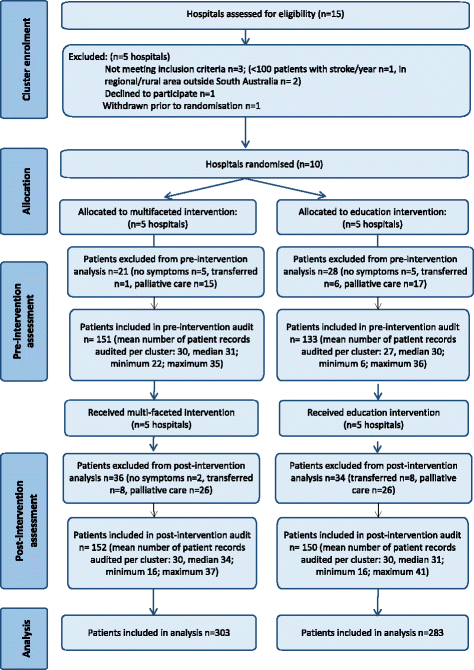Education-only versus a multifaceted intervention for improving assessment of rehabilitation needs after stroke; a cluster randomised trial
- PMID: 27604792
- PMCID: PMC5015218
- DOI: 10.1186/s13012-016-0487-2
Education-only versus a multifaceted intervention for improving assessment of rehabilitation needs after stroke; a cluster randomised trial
Abstract
Background: In 2011, more than half of the patients with stroke in Australian hospitals were not assessed for the need for rehabilitation. Further, there were no recommended criteria to guide rehabilitation assessment decisions. Subsequently, a decision-making tool called the Assessment for Rehabilitation Tool (ART) was developed. The ART was designed to assist Australian hospital clinicians to identify the rehabilitation needs of patients with stroke using evidence-based criteria. The ART was released and made freely available for use in 2012. This study evaluated the effectiveness of an education-only intervention (1 onsite education session and distribution of the ART) and a multifaceted intervention (2 or more onsite education sessions, distribution of the ART, audit and feedback, barrier identification, site-specific strategy development, promotion of interdisciplinary teamwork, opinion leaders and reminders) for improving assessments of rehabilitation needs after stroke.
Methods: Ten hospitals in 2 states of Australia were randomly assigned to an education-only or a multifaceted intervention. Medical records were audited by assessors blinded to group allocation before and after the implementation period. Difference in the proportion of patients assessed for rehabilitation before and after the intervention was analysed using mixed-effects logistic regression analysis, with time period as the dependent variable, an interaction between intervention type and time included to test for differences between the interventions, and hospital included as the random effect to account for patient clustering.
Results: Data from 586 patients (284 pre-intervention; 302 post-intervention; age 76 years, 59 % male) showed that the multifaceted intervention was not more effective than education-only in improving the proportion of patients whose rehabilitation needs were assessed (reference category education-only; odds ratio 1.29, 95 % confidence interval 0.63-2.67, p = 0.483). Post-intervention, the odds of a patient's rehabilitation needs being assessed was 3.69 times greater than pre-intervention (95 % confidence interval 2.57-5.30, p < 0.001). Evidence-based criteria were not consistently used when patients were deemed to have no rehabilitation needs.
Conclusions: A multifaceted intervention was not more effective than education-only in improving the assessment of rehabilitation needs of patients with stroke. Further interventions are required to ensure that all patients are assessed for the need for rehabilitation using evidence-based criteria.
Trial registration: ANZCTR (Australian New Zealand Clinical Trials Registry), ACTRN12616000340437.
Figures
References
-
- National Stroke Foundation. Clinical guidelines for stroke management 2010. Melbourne: National Stroke Foundation.
Publication types
MeSH terms
Associated data
LinkOut - more resources
Full Text Sources
Other Literature Sources
Medical



